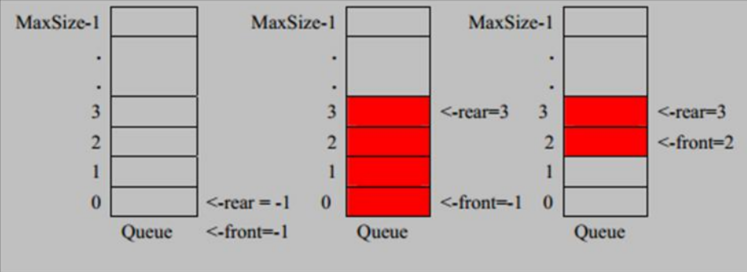基本介绍
- 队列是一个有序列表,可以用数组或链表来实现
- 遵循先入先出的原则。即:先存入队列的数据,要先取出。后存入的要后取出
数组模拟队列
队列本身是有序列表,若使用数组的结构来存储队列的数据,则队列数组的声明如下图,其中maxSize 是该队列的最大容量。
队列的输出、输入是分别从前后端来处理,因此需要两个变量front及rear分别记录队列前后端的下标,front会随着数据输出而
改变,而rear则是随着数据输入而改变,如图所示:

思路分析
- 当我们将数据存入队列时称为”addQueue”,addQueue 的处理需要有两个步骤:
- 将尾指针往后移: rear+1,当 front == rear 时,队列为空
- 若尾指针 rear 小于队列的最大下标 maxSize-1,则将数据存入rear所指的数组元素中,否则无法存入数据。
- rear == maxSize - 1[队列满]
- 当我们将数据存入队列时称为”addQueue”,addQueue 的处理需要有两个步骤:
代码实现
1
2
3
4
5
6
7
8
9
10
11
12
13
14
15
16
17
18
19
20
21
22
23
24
25
26
27
28
29
30
31
32
33
34
35
36
37
38
39
40
41
42
43
44
45
46
47
48
49
50
51
52
53
54
55
56
57
58
59
60
61
62
63
64
65
66
67
68
69
70
71
72
73
74
75
76
77
78
79
80
81
82
83
84
85
86
87
88
89
90
91
92
93
94
95
96
97
98
99
100
101
102
103
104
105
106
107
108
109
110
111
112
113
114
115
116
117
118
119
120
121
122
123
124
125
126
127package com.ysy.queue;
import java.util.Scanner;
public class ArrayQueueDemo {
public static void main(String[] args) {
//测试
//创建一个队列
ArrayQueue queue = new ArrayQueue(3);
char key = ' ';//接收用户输入
Scanner scanner = new Scanner(System.in);
boolean loop = true;
//输出一个菜单
while (loop){
System.out.println("s(show):显示队列");
System.out.println("e(exit):退出程序");
System.out.println("a(add):添加数据到队列");
System.out.println("g(get):从队列取出数据");
System.out.println("h(head):查看队列头的数据");
key = scanner.next().charAt(0);//接收一个字符
switch (key){
case 's':
queue.showQueue();
break;
case 'a':
System.out.println("请输入一个数");
int value = scanner.nextInt();
queue.addQueue(value);
break;
case 'g': //取出数据
try{
int res = queue.getQueue();
System.out.printf("取出的数据是%d\n", res);
}catch (Exception e){
//TODO: hadle exception
System.out.println(e.getMessage());
}
break;
case 'h': //查看队列头的数据
try{
int res = queue.headQueue();
System.out.printf("队列头的数据是%d\n", res);
}catch (Exception e){
//TODO: hadle exception
System.out.println(e.getMessage());
}
break;
case 'e': //退出
scanner.close();
loop = false;
break;
default:
break;
}
}
System.out.println("程序退出");
}
}
//使用数组模拟队列-编写一个ArrayQueue类
class ArrayQueue{
private int maxSize;//表示数组的最大容量
private int front;//队列头
private int rear;//队列尾
private int[] arr;//用于存放数据,模拟队列
//创建队列的构造器
public ArrayQueue(int arrMaxSize){
maxSize = arrMaxSize;
arr = new int[maxSize];
front = -1;//指向队列头部,分析出front是指向队列头的前一个位置
rear = -1;//指向队列尾部,指向队列尾的数据(即就是队列的最后一个数据)
}
//判读队列是否满
public boolean inFull(){
return rear == maxSize - 1;
}
//判断队列是否空
public boolean isEmpty(){
return rear == front;
}
//添加数据到队列
public void addQueue(int n){
//判断队列是否满
if(inFull()){
System.out.println("队列满,不能加入数据~");
return;
}
rear++;//让rear后移
arr[rear] = n;
}
//获取队列数据,出队列
public int getQueue(){
//判断队列是否空
if(isEmpty()){
throw new RuntimeException("队列空,不能取数据");
}
front++;//front后移
return arr[front];
}
//显示队列的所有数据
public void showQueue(){
//遍历
if(isEmpty()){
System.out.println("队列空,没有数据");
return;
}
for (int i = 0; i < arr.length; i++) {
System.out.printf("arr[%d]=%d\n", i, arr[i]);
}
}
//显示队列的头数据,注意不是取数据
public int headQueue(){
//判断
if(isEmpty()) {
System.out.println("队列空,没有数据");
}
return arr[front + 1];
}
}问题分析并优化
- 目前数组使用一次就不能用,没有达到复用的效果
- 将这个数组使用算法,改进成一个环形的队列 取模: %
数组模拟环形队列
- 分析说明
- 尾索引的下一个为头索引时表示队列满,即将队列容量空出-一个作为约定,这个在做判断队列满的时候需要注意**(rear + 1) % maxSize== front [满]**
- rear == front [空]
- 队列的最大有效数据 = maxSize - 1
- 分析示意图如下

思路分析
- front 变量的含义做一个调整 : front 就指向队列的第一个元素,也就是说ar[front]就是队列的第一个元素。front的初始值= 0
- rear 变量的含义做一个调整: rear 指向队列的最后一个元素的后一个位置,因为希望空出一个空间做为约定。rear的初始值=0
- 当队列满时,条件是(rear +1) % maxSize = front 【满】
- 对队列为空的条件,rear== front【空】
- 队列中有效的数据的个数**(rear + maxSize - front) % maxSize** // rear= 1 front=0
- 可以在原来的队列上修改得到一个环形队列
代码实现
1 | package com.ysy.queue; |



